

Natural Horsemanship
For many years we have practiced what is now known as natural horsemanship. Much of what humans do to horses derives from humans' need for convenience, fixing problems caused by humans, or in the benign but mistaken belief that horses need what humans would want in the same situation.
We discovered by trial and error that ways that fit in with the horse's natural life style work better for the horse, even if its is different from the man's traditional ways. For example, our horses are all barefoot. None have shoes. And they live outside all the time, not in a barn or stall.
Explore the tabs below to learn about other ways we practice natural horsemanship.
We also offer Natural Boarding so your horse or pony can enjoy these benefits. Visit our Natural Boarding page for more information.
Natural Hooves
Natural Diet
Riding Equipment
Additional Care

A Natural Hoof
A natural horse hoof is as hard as a rock; in fact, it shines like marble. These picture were taken without cleaning or picking the feet. They show how nature can take care of a horse's hoof - if it gets the chance.
A horse's hoof grows to respond to the demands placed on it. This stallion had been running on rock dust for several weeks. Rock dust is hard and abrasive, so the hoof grows and hardens. The result is an almost perfect hoof.
Hooves must be used -- walked on -- in order to be healthy. That's one of the reasons why keeping your horse in a stall or stable is the worst thing you can do for the health or your horse.
In a stall, a horse stands still, often on a soft, damp surface. The hooves don't get exercised. Hoof growth slows and the hoof softens. Then, when you ride, the horse's feet aren't acclimatized to the surfaces that you ride on, so you think he/she needs shoes.

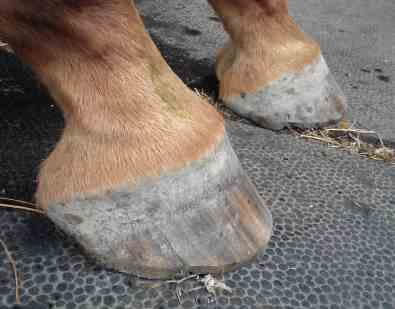
The second worst thing you can do is to put shoes on your horse. Walking makes the hoof work: the hoof expands and the middle is compressed. The compression pumps blood back up the horse's leg. A metal shoe prevents the hoof from expanding and therefore stops the pumping action, damaging the natural blood circulation.
Barefeet is better for horses in all circumstances. On hard surfaces -- i.e. pavement, gravel, or ice -- they have better grip. (Walking on ice with metal bars on your feet is called 'skating'!) With metal shoes, footfall on hard surfaces sends a shockwave up the entire leg. A barefoot hoof acts as a shock absorber. On gravel, you may find that a barefoot horse feels that gravel more than a shod horse. That's not because the shoes lift the horse off of the gravel; the metal isn't thick enough. It's because shod horses have the nerves in their feet deadened by the poor blood circulation.


Natural Diet
Horses aren't designed for 2 or 3 square meals a day. They have a digestive system optimized for digesting a large quantity of low nutrition roughage: natural grass. Our horses stay on pasture whenever these is grass to be eaten, and always have hay available - 24 x 7 x 366. Horses can stay fit and healthy on a diet of just grass and/ or hay, plus minerals.
Minerals
In a natural environment, horses hunger for the minerals they are deficient in and will seek the right minerals from all sorts of odd places: dirt, rocks, tree bark, even poop. Our horses always have access to more than just pasture, so there are many places for them to find minerals naturally. But, to make sure, we also provide ad-lib minerals. This picture depicts an experiment to show that horses are driven to the particular minerals they need, and also to find out which ones were needed. The trays contained 16 different minerals, and we observed the horses choosing specific ones.
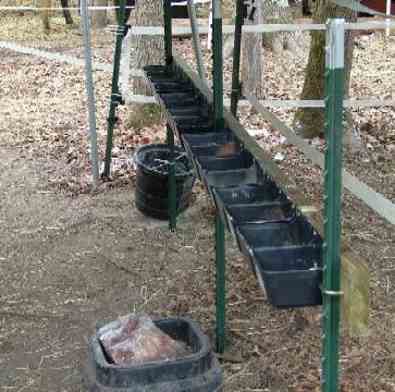
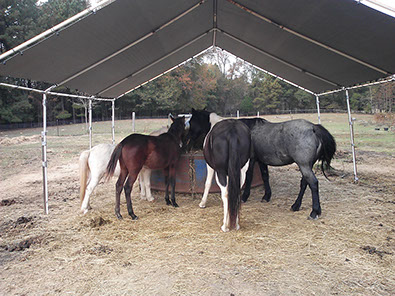
Hay Time
When the grass is low in winter, our horses are often found enjoying some hay at the feeder.
At The Pond
Our pastures try to mimic the natural environment as much as possible. This includes having a mix of grass and shade for the horses to enjoy, as well as access to water in their troughs or in the ponds.


A Bitless Bridle
While we use conventional saddles, we use bitless bridles as much as possible to try and decrease the impact on the horse's mouth and head.
As you can see, a bitless bridle looks like a halter, but the reins are looped through the rings at the cheek and connect to the headstall without a bit.
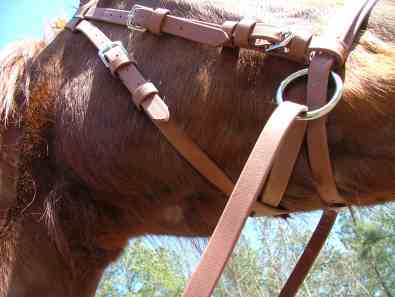

Balance
Practicing your balance is a good way to help both yourself and the horse. You will find it easier to stay on top of the horse; and the horse will find it easier to move properly underneath you.
We use conventional, English saddles for the majority of our lessons and trail rides. The use and fit of the saddles is important as they help protect the horse's back, as well as making the ride more comfortable for both of you. (But good balance is still necessary, even with a saddle and stirrups!)


Additional Care
Our horses are loved and well cared for, but they still work hard. In addition to quality nutrition and regular days off, we use several different techniques and therapies to help take care of the horses' muscles and keep them healthy and happy. These therapies include an equine chiropractor, Sure Foot Pads, PEMF and Back on Track.
Equine Chiropractor
The chiropractor adjusts the horses' spines and joints just like for a human -- though from higher heights!
Sure Foot Pads
Sure Foot Pads are thick pads that the horse can stand on to adjust and learn new ways of standing on their own feet. They are "a unique, innovative way for the horse to be his own teacher. Developed by Wendy Murdoch, this revolutionary way of improving your horse’s balance, confidence, movement and performance shows that the horse is always present and ready to learn if we can only find ways to access his intelligence."
For more information, visit their website.

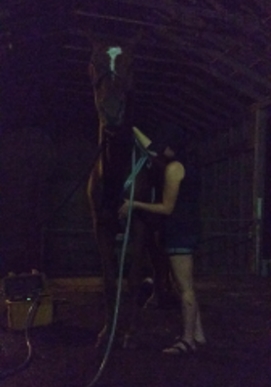
PEMF
Pulsed Electro-Magnetic Field Therapy is "a revolutionary technology which creates a safe, pulsing magnetic field, energizes the cells of the body and stimulates a body's ability to heal itself...without drugs or side-effects and often with immediate results."
For more information, visit their website.
Back On Track
"Weltex fabric utilizes the body's own energy and reflects the energy back as a far-infrared wavelength. That far-infrared wavelength penetrates deeper into the tissues. It is proven to increase blood circulation which, in turn, will increase the oxygen transport and waste product removal to and from the tissues, muscles, joints, tendon/ligaments, etc. It is a known fact that an increased blood circulation will aid in the overall well being and health of the tissues and also in healing from some trauma and injury."
For more information, visit their website.
